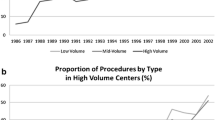Abstract
Introduction
There is a growing debate regarding outcomes following complex hepato-pancreato-biliary (HPB) procedures. The purpose of our study is to examine if facility type has any impact on complications, readmission rates, emergency department (ED) visit rates, and length of stay (LOS) for patients undergoing HPB surgery.
Methods
The SPARCS administrative database was used to identify patients undergoing complex HPB procedures between 2012 and 2014 in New York. Univariate generalized linear mixed models were fit to estimate the marginal association between outcomes such as overall/severe complication rates, 30-day and 1-year readmission rates, 30-day and 1-year ED-visit rates, and potential risk factors. Univariate linear mixed models were used to estimate the marginal association between possible risk factors and LOS. Facility type, as well as any variables found to be significant in our univariate analysis (p = 0.05), was further included in the multivariable regression models.
Results
There were 4122 complex HPB procedures performed. Academic facilities were more likely to have a higher hospital volume (p < 0001). Surgery at academic facilities were less likely to have coexisting comorbidities; however, they were more likely to have metastatic cancer and/or liver disease (p = 0.0114, < 0. 0001, and = 0.0299, respectively). Postoperatively, patients at non-academic facilities experienced higher overall complication rates, and higher severe complication rates, when compared to those at academic facilities (p < 0.0001 and = 0.0018, respectively). Further analysis via adjustment for possible confounding factors, however, revealed no significant difference in the risk of severe complications between the two facility types. Such adjustment also demonstrated higher 30-day readmission risk in patients who underwent their surgery at an academic facility.
Conclusion
No significant difference was found when comparing the outcomes of academic and non-academic facilities, after adjusting for age, gender, race, region, insurance, and hospital volume. Patients from academic facilities were more likely to be readmitted within the first 30-days after surgery.






Similar content being viewed by others
References
Reames BN, Ghaferi AA, Birkmeyer JD et al (2014) Hospital volume and operative mortality in the modern era. Ann Surg 260:244–251
Ross JS, Normand SL, Wang Y et al (2010) Hospital volume and 30-day mortality for three common medical conditions. N Engl J Med 362:1110–1118
Birkmeyer JD, Siewers AE, Finlayson EV et al (2002) Hospital volume and surgical mortality in the United States. N Engl J Med 346:1128–1137
Urbach DR, Baxter NN (2004) Does it matter what a hospital is “high volume” for? Specificity of hospital volume-outcome associations for surgical procedures: analysis of administrative data. Qual Saf Health Care 13:379–383
van Heek NT, Kuhlmann KF, Scholten RJ et al (2005) Hospital volume and mortality after pancreatic resection: a systematic review and an evaluation of intervention in the Netherlands. Ann Surg 242:781–788. [discussion 788–790]
van der Geest LG, van Rijssen LB, Molenaar IQ et al (2016) Volume-outcome relationships in pancreatoduodenectomy for cancer. HPB 18:317–324
Lieberman MD, Kilburn H, Lindsey M et al (1995) Relation of perioperative deaths to hospital volume among patients undergoing pancreatic resection for malignancy. Ann Surg 222:638–645
Sosa JA, Bowman HM, Gordon TA et al (1998) Importance of hospital volume in the overall management of pancreatic cancer. Ann Surg 228:429–438
Ho V, Heslin MJ (2003) Effect of hospital volume and experience on in-hospital mortality for pancreaticoduodenectomy. Ann Surg 237:509–514
Chamberlain RS, Tichauer M, Klaassen Z et al (2011) Complex pancreatic surgery: safety and feasibility in the community setting. J Gastrointest Surg 15:184–190
Kastenberg ZJ, Morton JM, Visser BC et al (2013) Hospital readmission after a pancreaticoduodenectomy: an emerging quality metric? HPB 15:142–148
Bakens MJ, van Gestel YR, Bongers M et al (2015) Hospital of diagnosis and likelihood of surgical treatment for pancreatic cancer. Br J Surg 102:1670–1675
Meguid RA, Ahuja N, Chang DC (2008) What constitutes a “high-volume” hospital for pancreatic resection? J Am Coll Surg 206:622 e621-629
Riall TS, Nealon WH, Goodwin JS et al (2008) Outcomes following pancreatic resection: variability among high-volume providers. Surgery 144:133–140
Rosemurgy AS, Bloomston M, Serafini FM et al (2001) Frequency with which surgeons undertake pancreaticoduodenectomy determines length of stay, hospital charges, and in-hospital mortality. J Gastrointest Surg 5:21–26
Eppsteiner RW, Csikesz NG, McPhee JT et al (2009) Surgeon volume impacts hospital mortality for pancreatic resection. Ann Surg 249:635–640
Schmidt CM, Turrini O, Parikh P et al (2010) Effect of hospital volume, surgeon experience, and surgeon volume on patient outcomes after pancreaticoduodenectomy: a single-institution experience. Arch Surg 145:634–640
Tseng JF, Pisters PW, Lee JE et al (2007) The learning curve in pancreatic surgery. Surgery 141:456–463
Singh S, Purohit T, Aoun E et al (2014) Comparison of the outcomes of endoscopic ultrasound based on community hospital versus tertiary academic center settings. Dig Dis Sci 59:1925–1930
Acknowledgements
We acknowledge the biostatistical consultation and support provided by the Biostatistical Consulting Core at School of Medicine, Stony Brook University.
Author information
Authors and Affiliations
Corresponding author
Ethics declarations
Disclosure
No industry or other external funding was used for this research. Dr. Pryor receives honoraria for speaking for Ethicon, Medtronic, Stryker, and Gore; is a consultant for the Medicines Company, Merck, and Intuitive. Dr. Altieri, Talamini, Yang, and Groves have nothing to disclose. Ms. Cagino and Ms. Yin have nothing to disclose.
Rights and permissions
About this article
Cite this article
Altieri, M.S., Yang, J., Groves, D. et al. Academic status does not affect outcome following complex hepato-pancreato-biliary procedures. Surg Endosc 32, 2355–2364 (2018). https://doi.org/10.1007/s00464-017-5931-0
Received:
Accepted:
Published:
Issue Date:
DOI: https://doi.org/10.1007/s00464-017-5931-0




